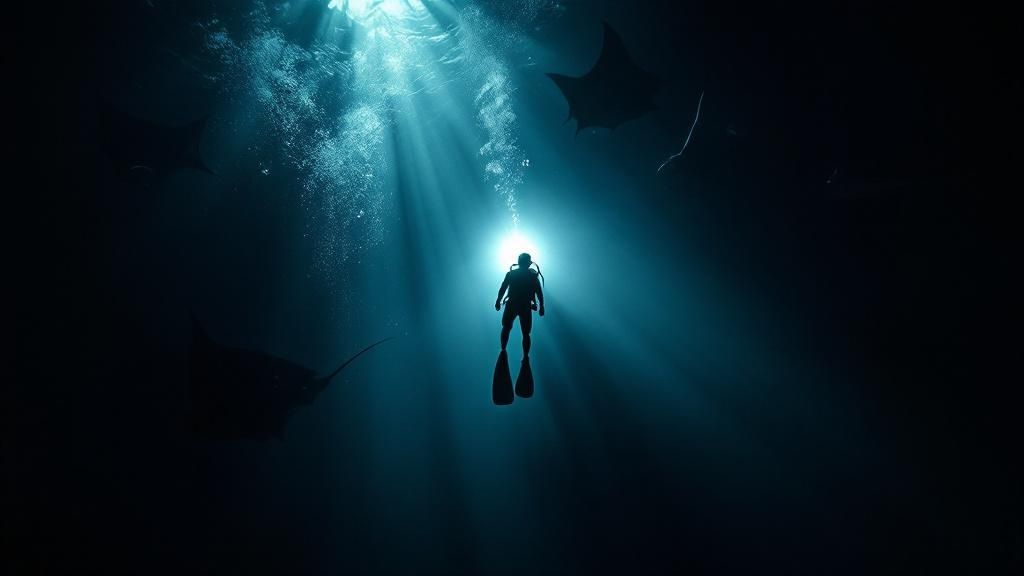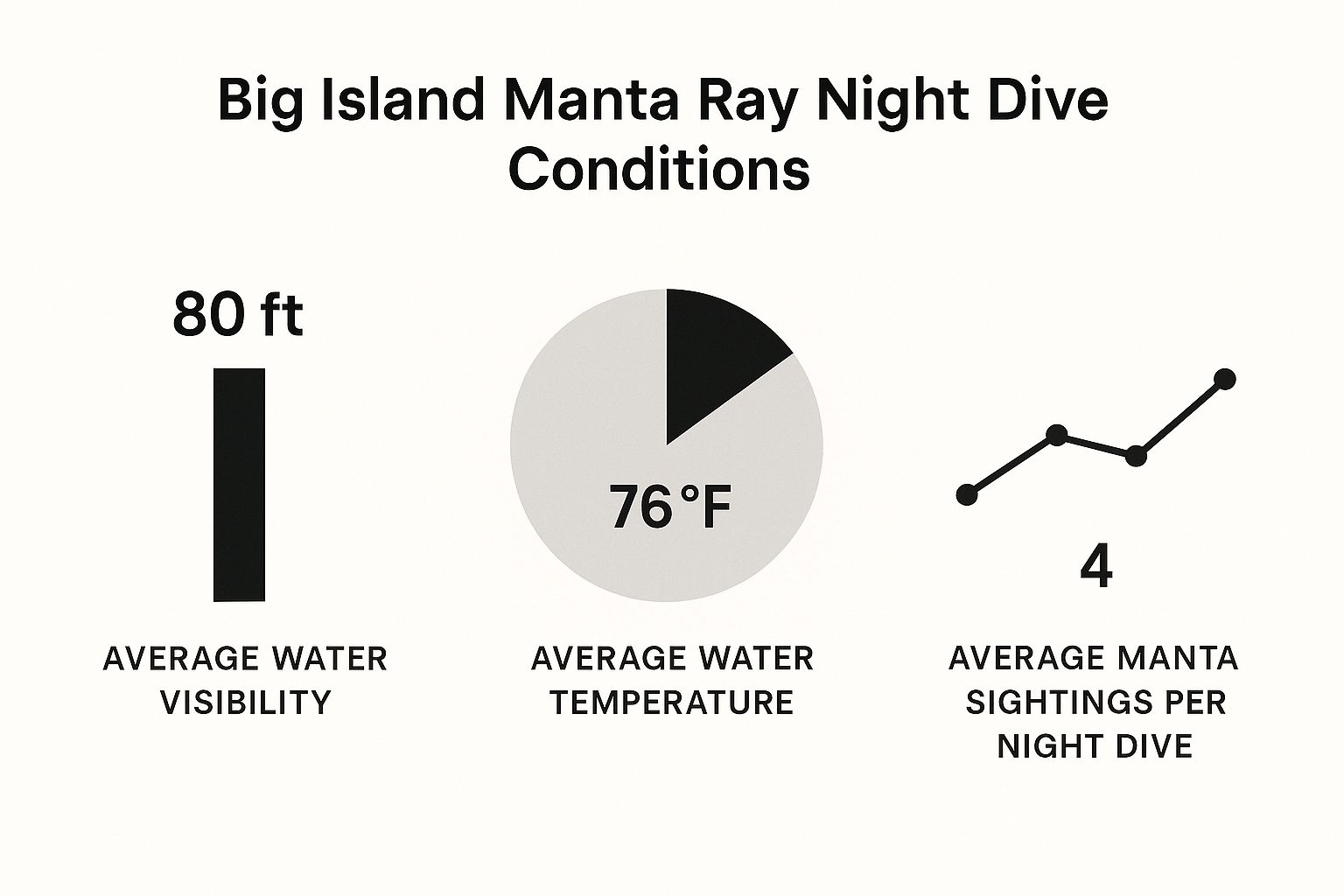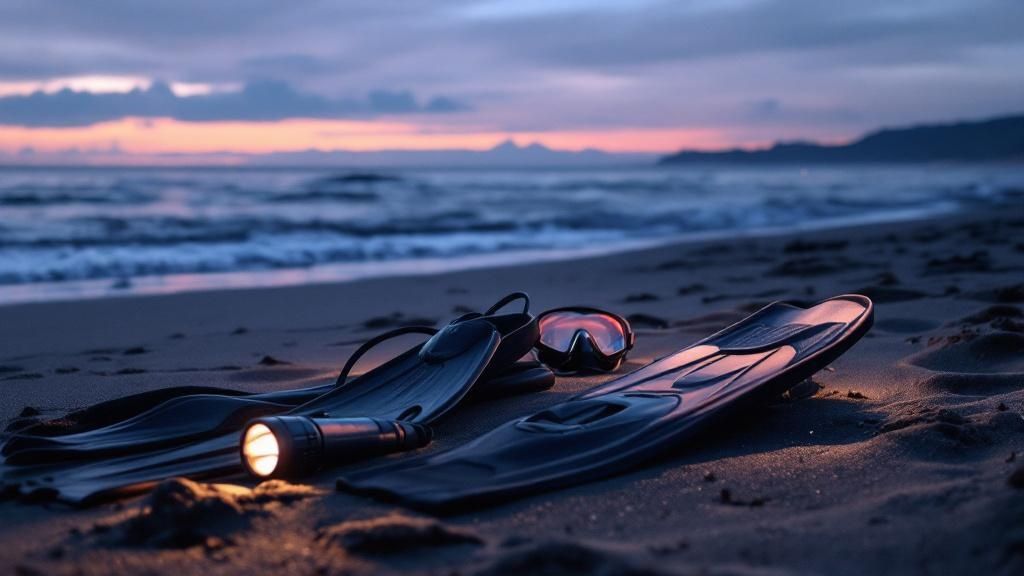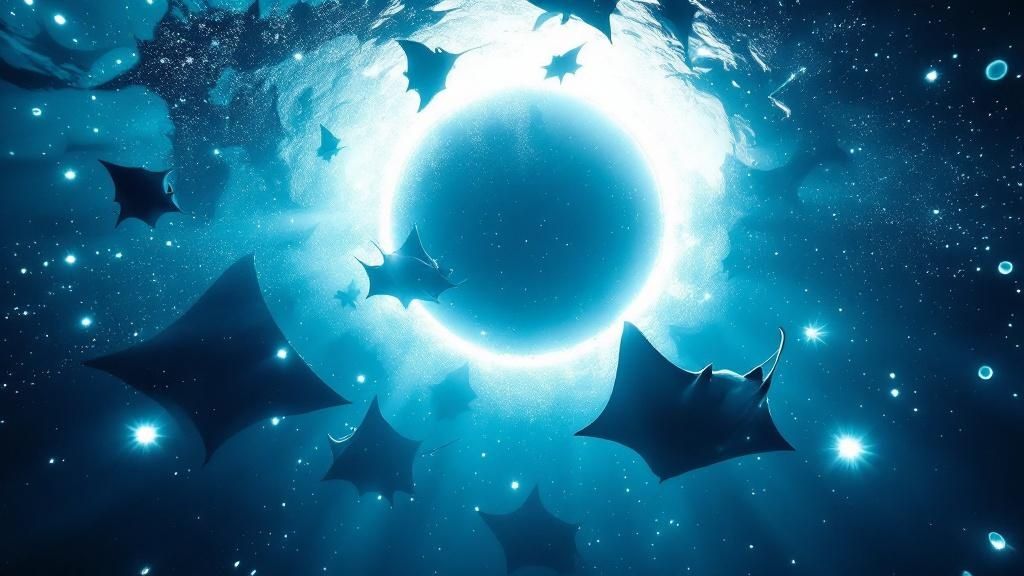Understanding Why These Night Dives Feel Magical
Picture this: you're floating in the dark depths of the Pacific, and a creature the size of a compact car suddenly appears. This isn’t science fiction—it’s the reality of a manta ray night dive off Hawaii’s Big Island. But why is this more than just seeing some big fish? Why do people describe it as a truly awe-inspiring experience? It all comes down to understanding what you’re actually seeing.
Imagine being invited to a silent, exclusive ballet, and you’re the only human in the audience. Your performers? Ancient ocean giants engaged in a captivating feeding ritual perfected over millions of years. The mantas aren’t simply swimming; they’re taking part in a complex feeding behavior, requiring precise timing, the perfect location, and just the right conditions.
The Magic of the Manta Ballet
These Big Island manta ray night dives become truly special when all these elements come together. You’re right there in the middle of an underwater ballet, with creatures boasting 12-foot wingspans performing graceful pirouettes and barrel rolls just inches from your face. Their white underbellies, lit up by dive lights, create a magical spectacle in the dark water. For a deep dive into planning your own manta ray night dive, check out our comprehensive guide: https://konahonudivers.com/big-island-manta-ray-night-dive/

This captivating display isn't accidental. Mantas are intelligent animals, responding to subtle changes in ocean currents, the concentration of plankton, and even the phases of the moon. These factors influence where and how they feed, adding another layer of fascination to the whole experience. The sheer number of people who want to do these dives speaks to their unique appeal. Roughly 80,000 people each year join snorkel and dive tours to see manta rays in Hawaiian waters, with Kona being a main hub. This high number shows the global interest in these amazing marine encounters. Discover more insights
More Than Just a Meal
The magic goes beyond the visual. The darkness enhances your other senses. You become much more aware of the subtle sounds of the ocean, the gentle rhythm of the reef at night. The anticipation builds as you float, suspended in a pool of light, waiting for the first shadowy shape to emerge.
The experience becomes even more meaningful when you think about the individual stories of these magnificent animals. Each manta ray you see has a name, a history, and a family tree that researchers have been carefully tracking for years. Some mantas have been coming back to these feeding grounds for over a decade, passing down learned feeding techniques through generations.
When a manta ray does a flip just inches from your mask, it isn’t just feeding—it’s possibly performing a behavior learned from its ancestors, a link in a chain of oceanic tradition going back thousands of years. This understanding changes the experience from passively watching wildlife to actively witnessing living history unfold before your eyes. It's this blend of natural wonder, scientific knowledge, and sensory immersion that creates the true magic of a Big Island manta ray night dive.
Prime Dive Sites: Where Magic Actually Happens
Not all manta ray encounters are the same. The location you choose dramatically shapes the whole experience. Think of it like choosing between a cozy jazz club and a massive concert hall. Both offer incredible music, but the vibe is totally different. Similarly, the Big Island has two main spots for manta ray night dives, each with its own distinct personality.
Garden Eel Cove: The Intimate Jazz Club
Garden Eel Cove, just north of Kona, offers a more personal experience, like a small jazz club. Smaller dive groups and shallower water often mean you'll get closer to the mantas. When the conditions are just right, you might even find yourself surrounded by these curious creatures, almost like you've stumbled into a private show.
Keauhou Bay: The Grand Concert Hall
South of Kailua Kona, Keauhou Bay provides a larger, more dramatic setting. Think of it as a concert hall for manta rays. The deeper water and special lighting effects create a truly spectacular atmosphere. This site can handle bigger groups, so more people can witness the majesty of these gentle giants.
What makes the mantas choose one “venue” over the other on a given night? It's not just random. These intelligent animals react to subtle changes in the ocean currents, the amount of plankton in the water, and even the phases of the moon. Experienced dive operators learn to interpret these clues, strategically picking the best dive site based on factors most people wouldn't even consider.

This infographic shows you what to expect on a typical Big Island manta ray night dive. It compares average water visibility (80 ft), average water temperature (76°F), and the average number of manta rays seen per dive (4). The data consistently shows excellent visibility and comfortable water temperatures, perfect for observing these amazing creatures. Plus, with an average of four mantas per dive, your chances of a truly unforgettable experience are high.
To help you choose the right dive site for you, take a look at the table below comparing Garden Eel Cove and Keauhou Bay.
Kona Manta Ray Dive Sites Comparison
| Site Name | Location | Average Manta Count | Best Conditions | Dive Depth | Experience Level |
|---|---|---|---|---|---|
| Garden Eel Cove | North of Kona | Fewer, but closer | Calm seas | Shallower | Beginner-friendly |
| Keauhou Bay | South of Kailua-Kona | More | Some current OK | Deeper | All levels |
One of the most remarkable things about manta ray night dives on the Big Island is how often you actually see mantas. On average, divers and snorkelers spot manta rays about 85-90% of the time at these two main locations. This incredibly high success rate is because these areas are rich in plankton, the mantas' main food source, drawing them in for their nightly feasts. Find more information on manta ray sightings here.
Understanding these natural factors makes the experience even more rewarding. Knowing that the moon's cycle influences plankton behavior, which then affects the manta rays' feeding patterns, helps you appreciate the intricate connections between these creatures and their environment. It’s this connection that elevates a Big Island manta ray night dive from a simple sightseeing trip to a truly unforgettable experience. Choosing the right dive operator is key, as their knowledge of these conditions can significantly improve your chances of an extraordinary encounter.
The Science Behind Those Incredible Encounters
These aren't just chance encounters with random sea creatures on a Big Island manta ray night dive. Think of it more like attending a well-choreographed underwater ballet, where each manta ray has a name, a history, and a story that researchers have been carefully tracking for years. It’s like having a detailed program with bios of each performer.
Scientists have discovered that manta rays have complex social structures, preferred hangouts, and even established, long-lasting friendships. Some individuals, like a female affectionately known as "Big Bertha," have graced these feeding grounds for over fifteen years, raising generations of offspring and passing down the best feeding techniques. This inherited wisdom makes the experience even more special.
Unraveling Manta Ray Behavior
This research reveals something truly amazing: these graceful creatures aren't just feeding haphazardly; they’re exhibiting complex behaviors. These include cooperative feeding strategies, learning from each other, and even what looks like play. Imagine a manta ray doing a graceful somersault right in front of your mask, possibly mirroring a feeding pattern learned from its grandmother. It’s like witnessing the continuation of ancient oceanic customs.
The Kona Coast, where these dives take place, has been a hub for extensive manta ray research. From 2009 to 2014, scientists meticulously documented manta ray sightings, carefully noting individual identification, health, and movement patterns within their territory. Discover more insights into this fascinating research. This long-term study has unlocked valuable information about the lives of these gentle giants.
A Deeper Connection
Knowing these details elevates a simple wildlife encounter to something truly meaningful. You're not just watching animals; you're observing a complex society with its own history, culture, and traditions. This deeper understanding is what makes the Big Island manta ray night dive so captivating.
You might be interested in checking out Kona Honu Divers' Manta Ray Night Dive experience. They are known for their dedication to responsible diving practices and making the most of your encounter. The awe-inspiring nature of these dives is amplified by the knowledge that these creatures aren't just passing through—they’re part of a thriving community. By participating, you get a front-row seat to their remarkable lives. It’s a true privilege to share the water with such intelligent and magnificent beings.

Gear That Makes or Breaks Your Experience

Getting ready for a Big Island manta ray night dive isn’t about owning the most expensive gear. It's more about understanding the role each piece plays in this unique underwater encounter. Think of it like choosing the right outfit for a special occasion: comfort, safety, and not disturbing the scene are key.
Lighting: The Subtle Art of Underwater Illumination
Lighting is essential for these dives, but it's a delicate balancing act. Too much light, and you’ll scatter the plankton the mantas feed on, much like turning on stadium lights during a quiet dinner party. Too little light, and you’ll miss the intricate details of the manta rays’ graceful movements.
The perfect lighting setup comes from understanding how light works underwater and how mantas react to different light wavelengths. Divers typically use dive lights pointed upwards, creating a glowing attraction for plankton, and as a result, the mantas themselves.
Thermal Protection: Staying Warm for Close Encounters
Staying warm is vital, not only for your comfort but also to keep you still. Imagine trying to enjoy a beautiful piece of music while shivering uncontrollably. Similarly, being cold during a manta ray night dive prevents the calm presence that encourages these gentle giants to approach. A full wetsuit or drysuit is highly recommended, as ocean temperatures can drop noticeably after sunset.
Masks and Fins: Enhancing Your Underwater Vision and Movement
Even your mask and fins play a significant role. A bulky mask can restrict your view, like trying to watch a play through binoculars. Oversized fins can stir up the bottom, making the water cloudy and potentially disturbing the mantas, similar to kicking up dust in a quiet room. Low-profile masks and fins allow you to move smoothly and see clearly.
The Veteran Diver's Kit: Tried-and-True Gear Configurations
Experienced manta ray divers have honed their gear choices over many dives. They often prefer small, powerful dive lights that attract plankton effectively without being too bright. If you're interested in improving your dive gear knowledge, check out our Kona scuba certification course. They combine these lights with streamlined wetsuits for warmth and freedom of movement, allowing them to move with grace and maintain a respectful distance.
Their mask and fin choices emphasize clear vision and minimal disruption, creating a truly immersive experience for both diver and manta. These choices aren’t about having the "best" equipment, but the right equipment. It's about respecting the environment and making the most of this special interaction. By carefully considering each piece of gear, you improve not just your own experience, but also protect these magnificent creatures.
Your Night Dive Experience: Moment by Moment
As the sun dips below the horizon, painting the sky in hues of orange and purple, the excitement for your Big Island manta ray night dive begins to build. But what can you truly expect once you’re beneath the waves in the darkness? Let’s walk through the experience, from the initial plunge to the magical manta ray encounter.
Entering a New World of Senses
Night diving is a completely different sensory experience than diving during the day. Imagine suddenly relying more on your ears than your eyes. The reef comes alive with subtle sounds you'd never notice in daylight – the clicks and pops of crustaceans, the rustling of coral polyps. This heightened sense of awareness only adds to the anticipation. Floating in the circle of your dive light, you’ll find yourself wondering, “Will tonight be the night?” The suspense is palpable.
You’ll feel it too, the slight chill in the water as the sun's warmth fades. Even the familiar pressure of the water against your skin seems somehow intensified in the dark. You are a visitor in a nocturnal realm, and it feels different. This is the transition to the night shift on the reef.
The First Sighting
Then, out of the blue, a shadow appears. A large, graceful wing glides past, and your heart skips a beat. You're face-to-face with a manta ray. This first sighting is often an electrifying moment, a mixture of awe and pure exhilaration. It sets the stage for what is to come. And every encounter is unique.
Manta Ray Encounters: From Solo Performances to Underwater Symphonies
Sometimes, a single, curious manta ray might decide you’re worth investigating. It might circle your group, its huge, inquisitive eyes seeming to study you as much as you’re studying it. This intimate encounter feels like a private ballet, a privilege to witness.
On other nights, you might experience what divers call "manta trains"—multiple rays feeding together in a perfectly synchronized dance. This underwater symphony of motion, with these gentle giants gracefully swirling and looping, is utterly mesmerizing.
This screenshot from the Kona Honu Divers website offers a glimpse into their dedication to creating a safe and high-quality dive experience. Their clear and informative site highlights their commitment to customer satisfaction, a crucial element for any manta ray night dive. Choosing a reputable operator like Kona Honu Divers elevates the entire experience, ensuring not just a sighting, but a truly unforgettable memory.
An Unexpected Emotional Response
Many divers find themselves unexpectedly moved by the encounter. Some even experience "manta tears"—the surprising phenomenon of crying inside your mask, overcome by the sheer beauty and grace of these creatures. It's a testament to the powerful connection we can feel with the natural world, particularly in an environment as unique and awe-inspiring as this.
These moments of pure wonder are what distinguish manta ray night dives from any other underwater adventure. The combination of darkness, graceful movement, and the impressive size of the mantas creates a truly unforgettable spectacle.
Choosing Your Dive Operator: What Really Matters
When it comes to Big Island manta ray night dives, the difference between a good experience and an unforgettable one often comes down to the small details. It's not just about price or convenience. It’s about finding an operator who truly understands the delicate balance of these incredible encounters.
Guardians of the Manta Rays
The best operators act as guardians, protecting both you and the manta rays. They understand that they're facilitating a very special interaction between humans and these gentle giants. Over years, they’ve developed a deep respect for these animals and learned to anticipate their behavior. This allows them to position divers for the best possible views without disturbing the mantas’ natural feeding habits.
Think of it like attending a concert. Would you rather be crammed in a crowded space, or seated comfortably with a clear view of the stage? Similarly, smaller dive groups mean better viewing angles, more personalized attention from the guide, and a less intrusive presence for the mantas.
This personalized approach transforms the experience from a typical tourist activity into something far more meaningful. It fosters a deeper connection with the mantas and their environment.
The Role of the Dive Guide
Your dive guide plays a pivotal role in shaping your experience. Exceptional guides go beyond simply ensuring your safety. They're like expert interpreters, translating the nuances of manta ray behavior. They can identify individual mantas, explain their social interactions, and even predict when a close encounter might occur.
Imagine exploring a foreign country with a knowledgeable local guide. They can point out things you might miss, share fascinating insights, and help you connect with the local culture on a deeper level. Similarly, a skilled manta ray dive guide unlocks a whole new dimension of understanding about these amazing creatures. They enhance your appreciation for the complex feeding behaviors and social dynamics you're observing.
Finding the Right Fit
Choosing the right operator for your Big Island manta ray night dive requires careful thought. You might be interested in learning more about Kona Honu Divers, voted the best dive operator in Kona, Hawaii. Prioritize operators who emphasize small group sizes, demonstrate a genuine respect for the mantas, and have highly experienced guides. These factors are far more valuable than a flashy website or a cheap price. They are the hallmarks of an operator who understands the magic of these encounters and strives to share it responsibly.
To help you compare options, here's a breakdown of different tour types:
Manta Ray Tour Options Comparison: This table compares different tour types, including diving vs. snorkeling options, group sizes, and what's included.
| Tour Type | Experience Level | Group Size | Duration | Included Equipment | Price Range |
|---|---|---|---|---|---|
| Manta Ray Night Dive | Certified Diver | 6-8 | 1.5-2 hours | Tanks, weights, dive lights | $150-$200 |
| Manta Ray Night Snorkel | Beginner | 8-12 | 1.5-2 hours | Snorkel gear, flotation devices, lights | $120-$150 |
| Private Dive Charter | Certified Diver | Customizable | 2-3 hours | Customizable | $500+ |
As you can see, there are options for various experience levels and budgets. While snorkeling offers a fantastic introduction to manta rays, diving allows for a more immersive experience. Private charters offer ultimate flexibility but come at a premium. Choosing the right tour ensures a richer, more meaningful experience – a memory that will stay with you long after your vacation ends.
Planning Your Perfect Underwater Adventure
Success on a Big Island manta ray night dive isn't a matter of just showing up. It takes planning, much like orchestrating a trip to see the Northern Lights. Timing, conditions, and preparation are everything. One of the most critical factors? The lunar cycle.
The moon influences plankton, which in turn dictates the manta rays' feeding habits. New moon periods often offer the most spectacular viewing opportunities. Think of it like this: darker skies make underwater lights more effective at concentrating plankton. This acts like a giant spotlight, drawing in more manta rays and making them easier to see as they gracefully feed. Intrigued? You can learn more about the magical manta ray night dive in Hawaii.
Timing is Everything: Weather and Flexibility
Weather plays a significant role, too. Wind and currents affect where the plankton gathers and, consequently, where the mantas decide to dine. Imagine trying to enjoy a picnic on a blustery day – you'd be constantly chasing your napkins! Mantas, like picnickers, prefer calmer waters where their food source is abundant, which is why checking the forecast is essential for a successful dive.
This is where being flexible with your booking dates becomes invaluable. Being able to shift your dive based on the conditions can dramatically improve your experience. Having a few extra days on the Big Island specifically for the dive allows you to wait for the ideal conditions, increasing your odds of an unforgettable encounter.
Building Your Itinerary Around the Dive
It might sound extreme, but consider structuring your entire Big Island trip around your manta ray night dive. This is a rare and special experience, after all. Building in the option to reschedule if the weather isn't cooperative on your initial date significantly increases your chances of seeing these gentle giants.
This strategy also helps reduce stress. Picture arriving for your pre-booked dive only to learn it’s cancelled due to choppy seas. Having backup days built into your itinerary lets you easily reschedule and enjoy other Big Island activities, eliminating the disappointment of a missed opportunity.
The goal isn't simply to see manta rays. It's about experiencing something truly breathtaking. It's about being present on those special nights when the conditions align, and the underwater world puts on an unforgettable show.
Experience the magic of the manta rays with Kona Honu Divers. Book your unforgettable Big Island manta ray night dive today!
